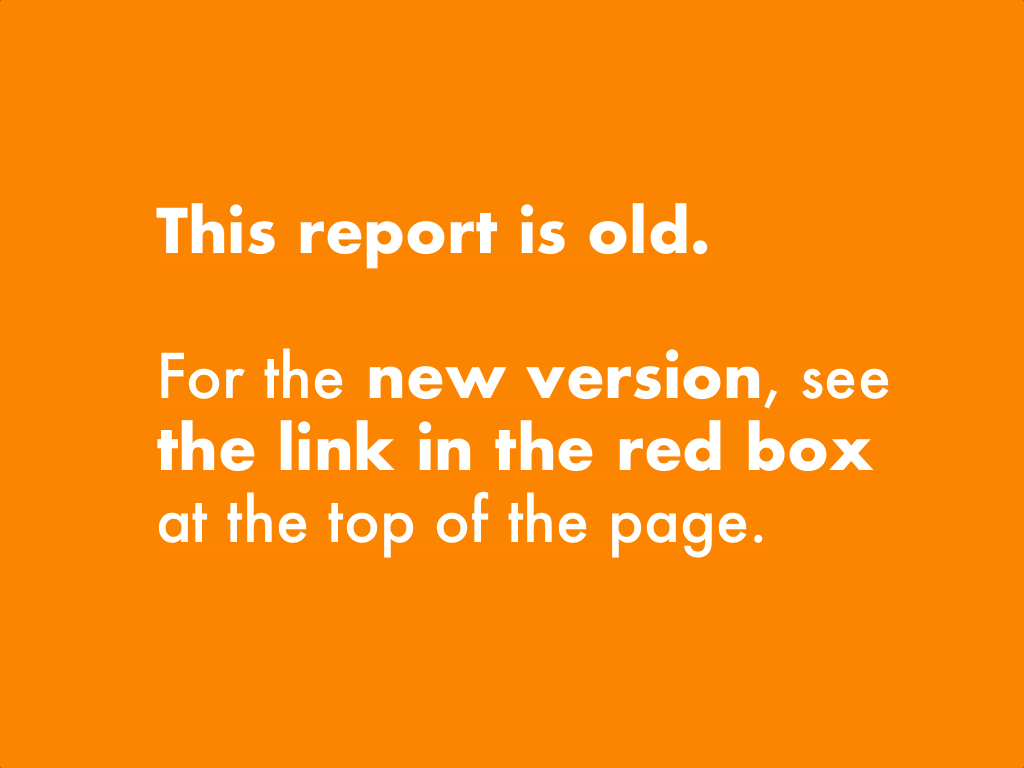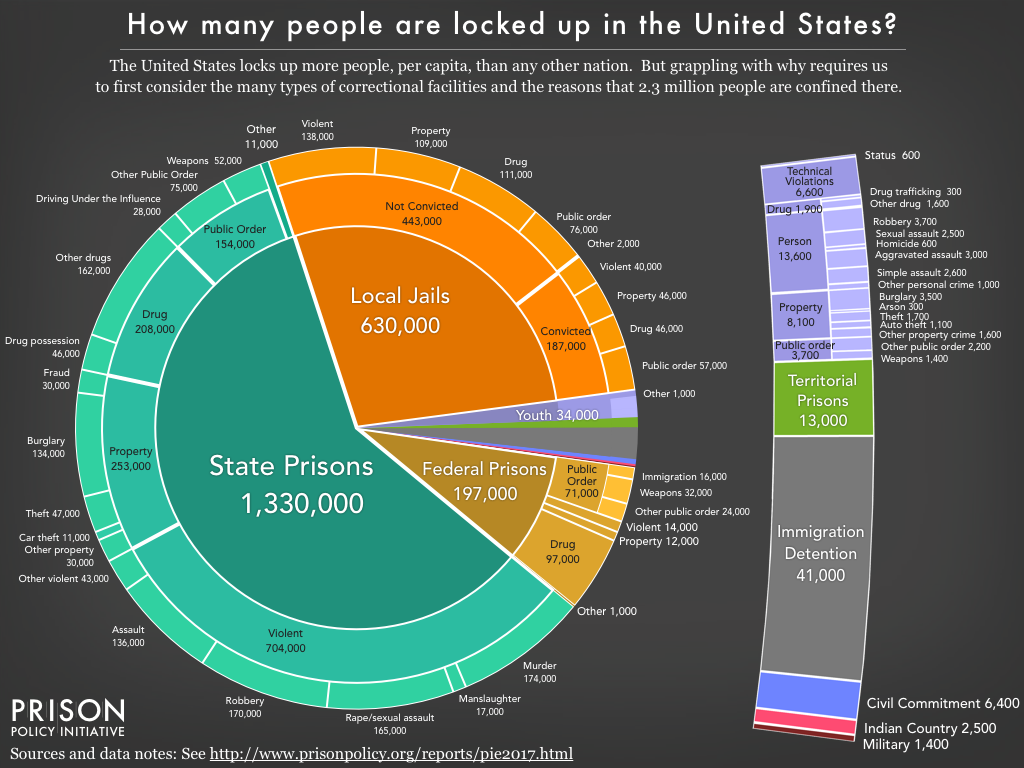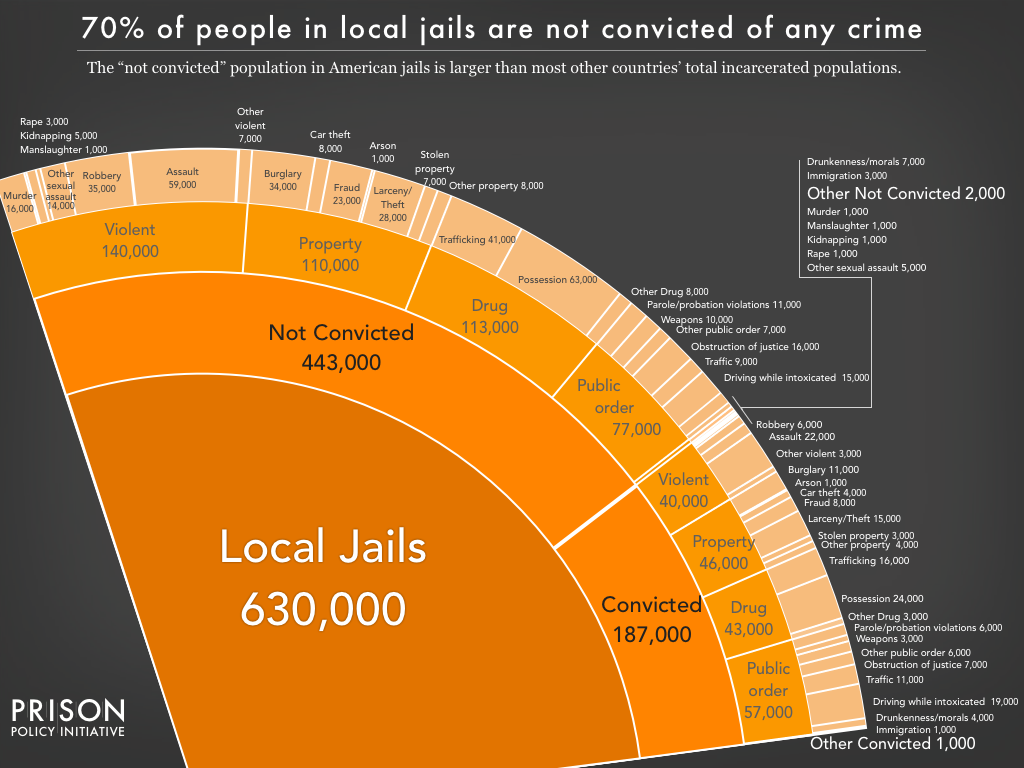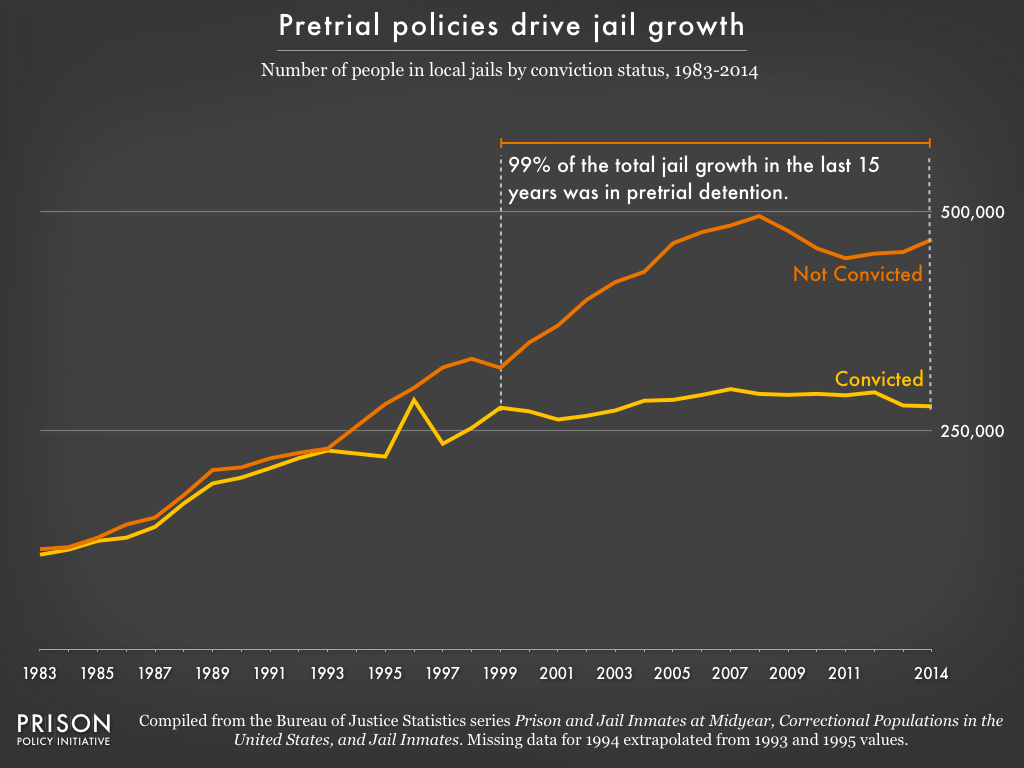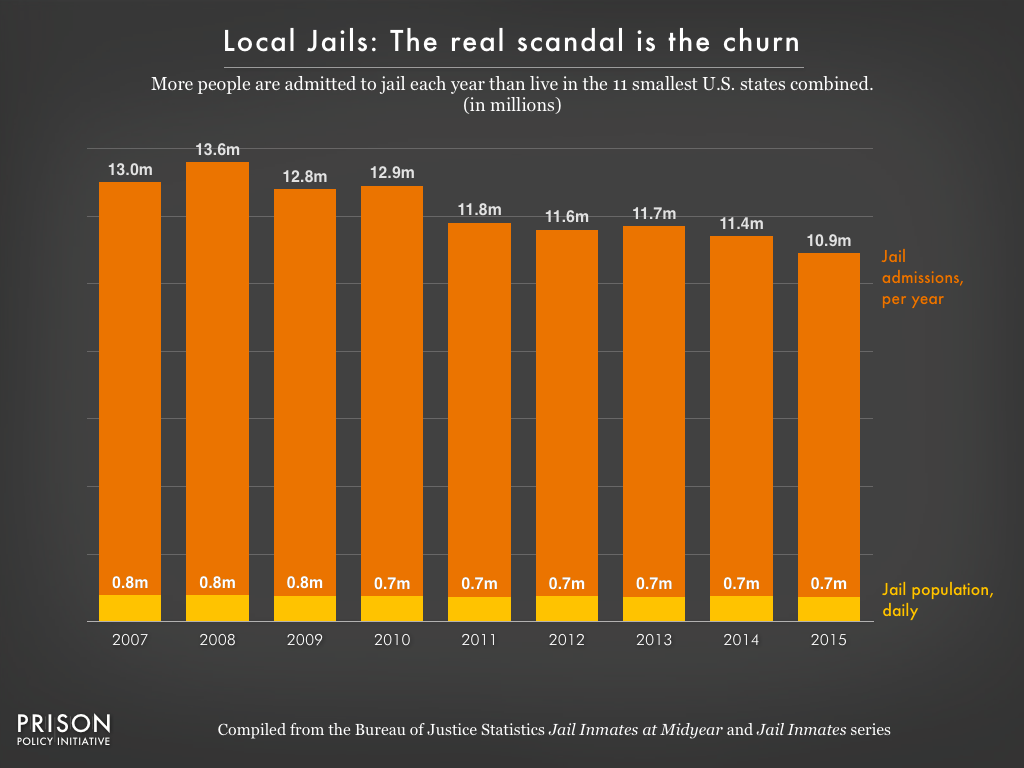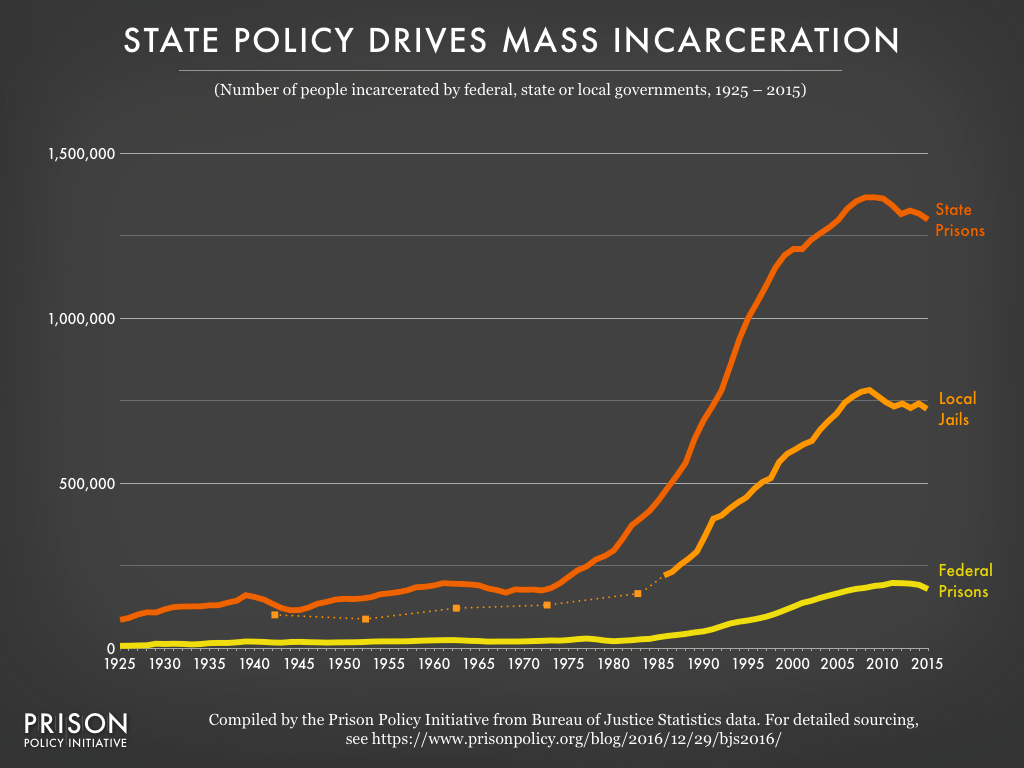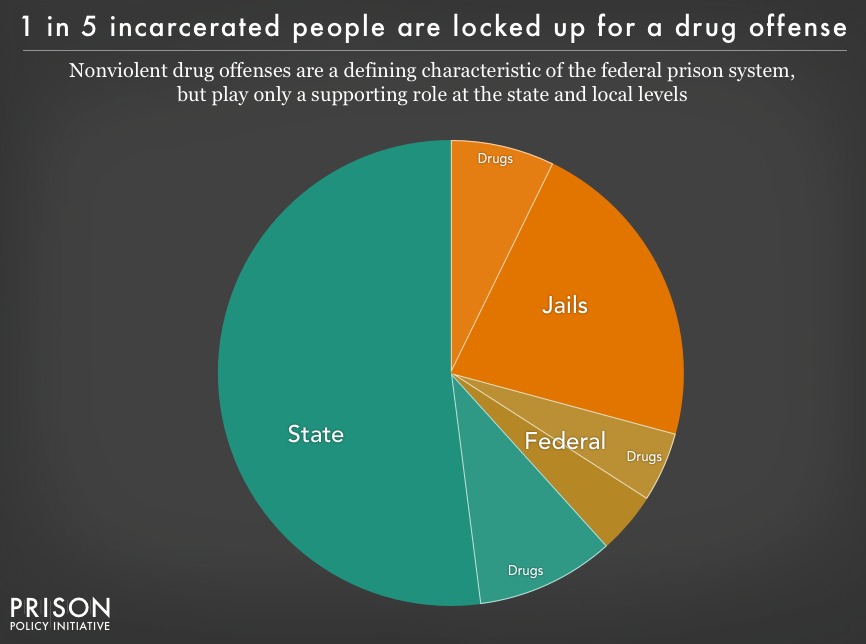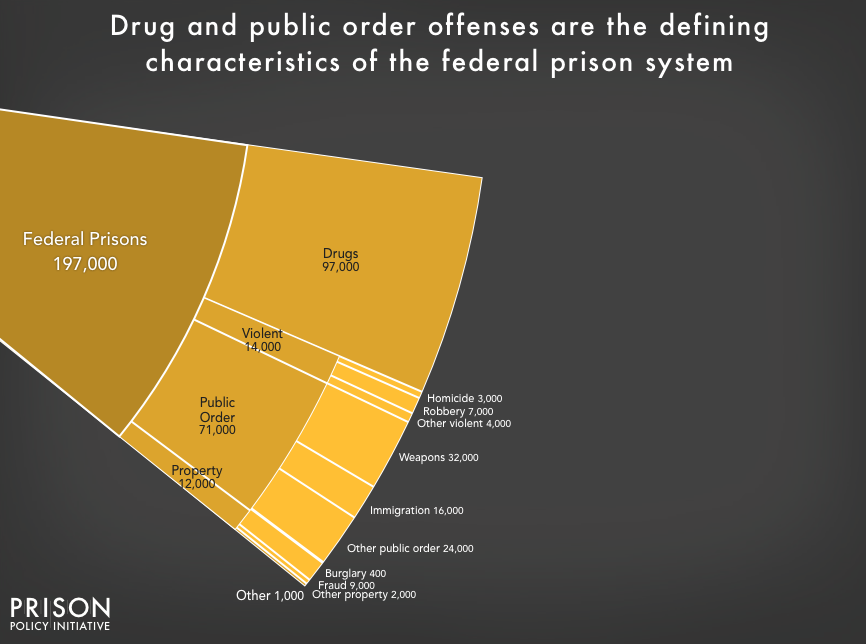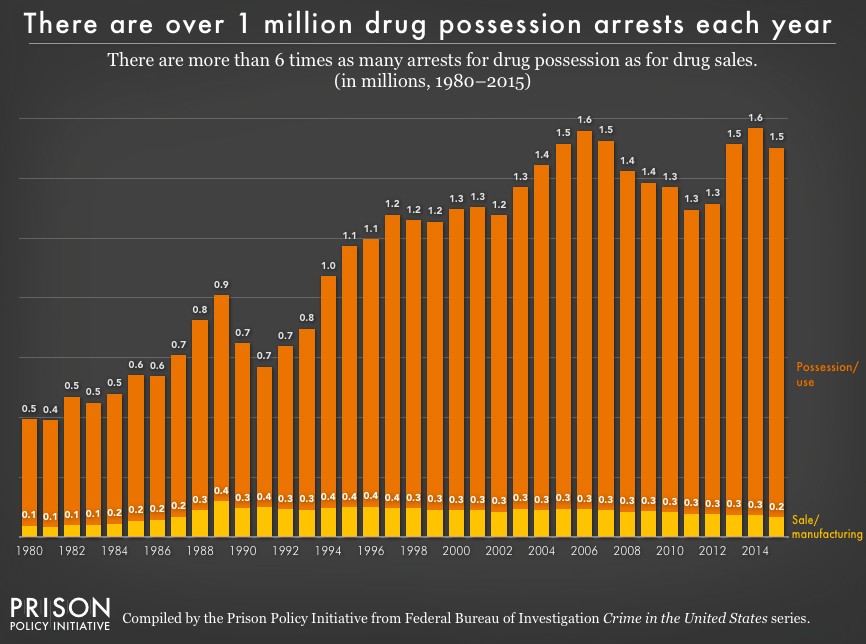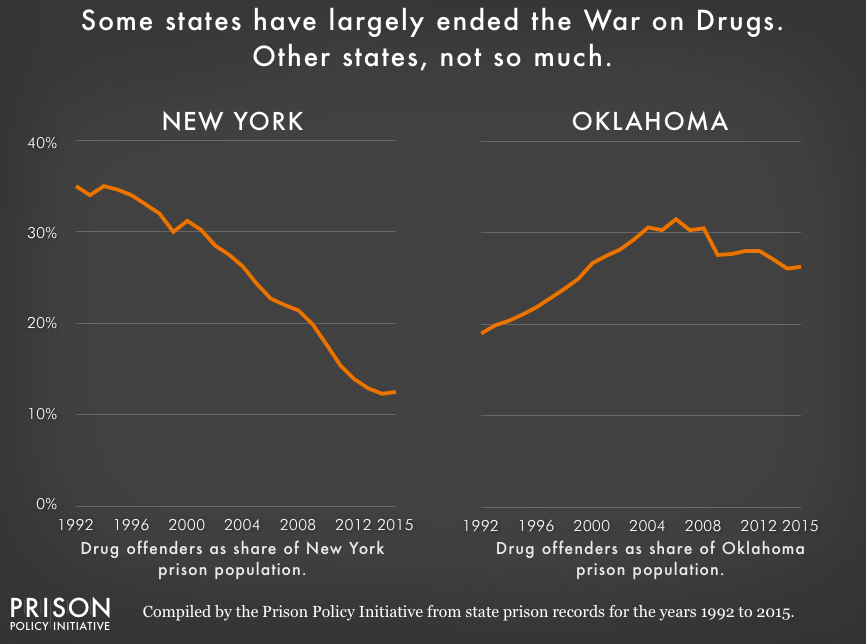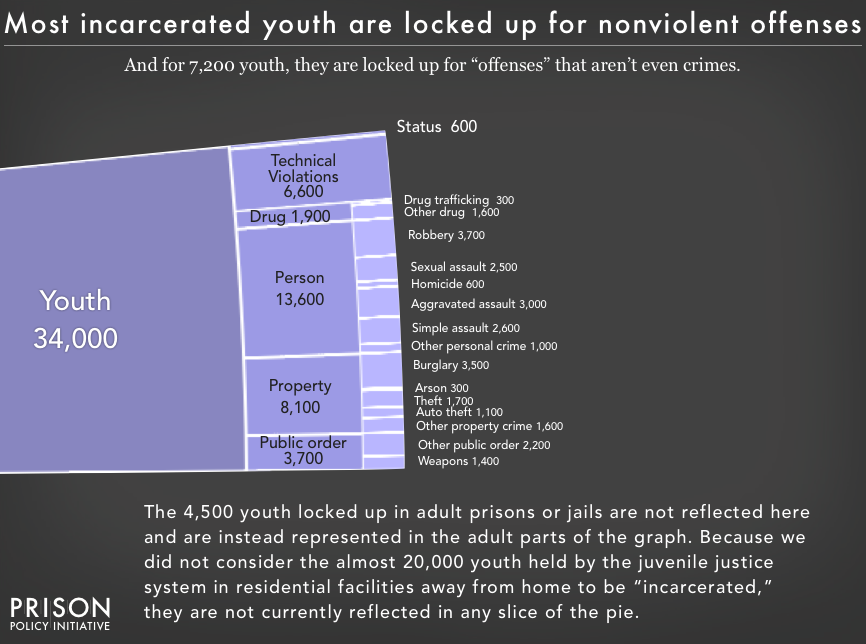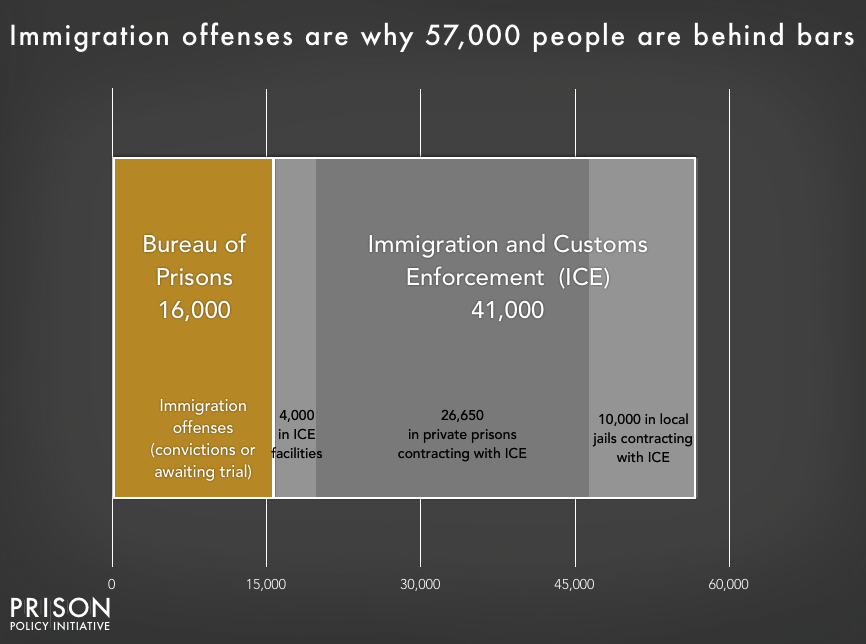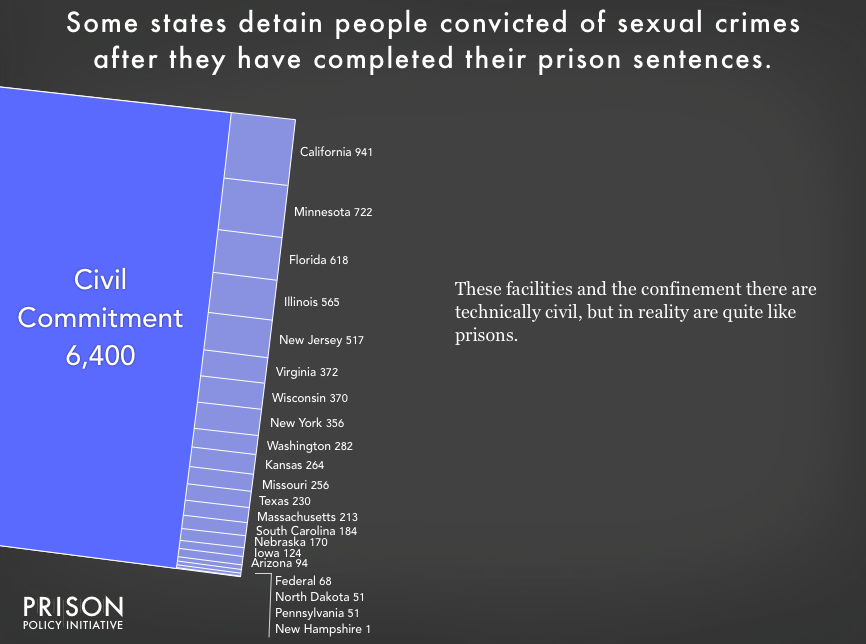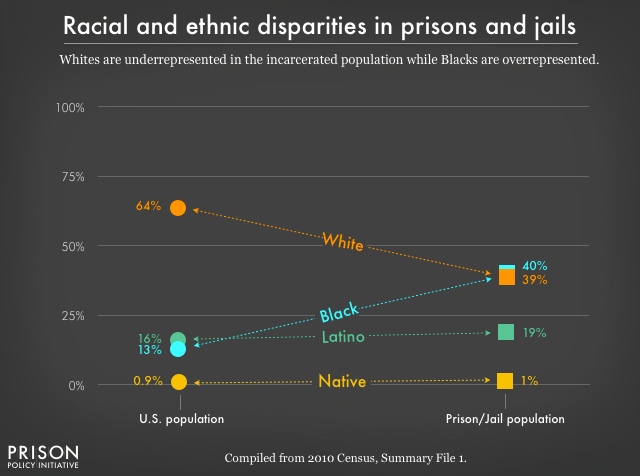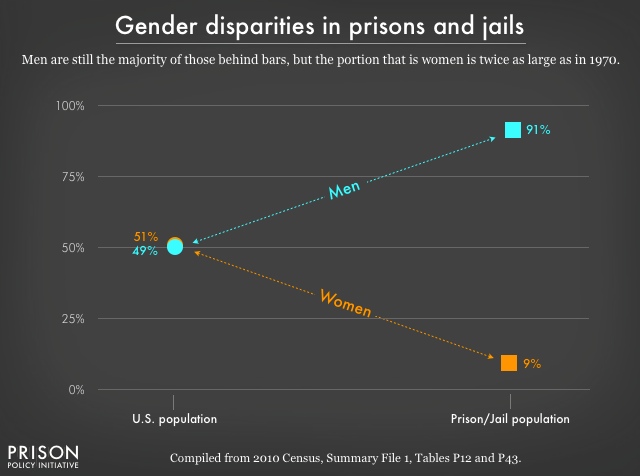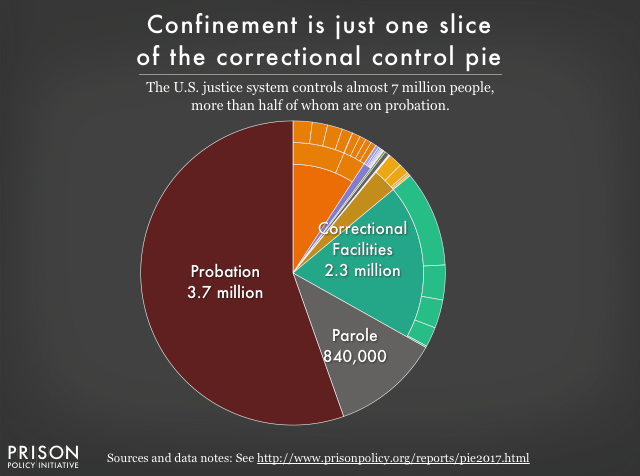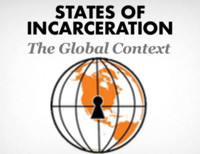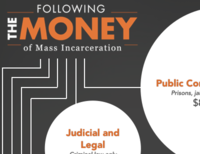Mass Incarceration: The Whole Pie 2017
By Peter Wagner and Bernadette Rabuy
March 14, 2017
Press release
This report is old. See our new version.
Wait, does the United States have 1.3 million or more than 2 million people in prison? Are most people in state and federal prisons locked up for drug offenses? Frustrating questions like these abound because our systems of confinement are so fragmented and controlled by various entities. There is a lot of interesting and valuable research out there, but varying definitions make it hard — for both people new to criminal justice and for experienced policy wonks — to get the big picture.
This report offers some much needed clarity by piecing together this country’s disparate systems of confinement. The American criminal justice system holds more than 2.3 million people in 1,719 state prisons, 102 federal prisons, 901 juvenile correctional facilities, 3,163 local jails, and 76 Indian Country jails as well as in military prisons, immigration detention facilities, civil commitment centers, and prisons in the U.S. territories.1 And we go deeper to provide further detail on why people are locked up in all of those different types of facilities.
This report is old. See our new version.
While this pie chart provides a comprehensive snapshot of our correctional system, the graphic does not capture the enormous churn in and out of our correctional facilities and the far larger universe of people whose lives are affected by the criminal justice system. Every year, 641,000 people walk out of prison gates, but people go to jail over 11 million times each year.2 Jail churn is particularly high because most people in jails3 have not been convicted. Some have just been arrested and will make bail in the next few hours or days, and others are too poor to make bail and must remain behind bars until their trial. Only a small number (187,000 on any given day) have been convicted, generally serving misdemeanors sentences under a year.
With a sense of the big picture, a common follow-up question might be: how many people are locked up for a drug offense? We know that almost half a million people are locked up because of a drug offense.4 The data confirms that nonviolent drug convictions are a defining characteristic of the federal prison system, but play only a supporting role at the state and local levels. While most people in state and local facilities are not locked up for drug offenses, most states’ continued practice of arresting people for drug possession5 destabilizes individual lives and communities. Drug arrests give residents of over-policed communities criminal records, which then reduce employment prospects and increase the likelihood of longer sentences for any future offenses.
All of the offense data presented comes with an important set of caveats. A person in prison for multiple offenses is reported only for the most serious offense6 so, for example, there are people in prison for “violent” offenses who might have also been convicted of a drug offense. Further, almost all convictions are the result of plea bargains, where people plead guilty to a lesser offense, perhaps of a different category or one that they may not have actually committed.
And many of these categories group together people convicted of a wide range of offenses. For example, “murder” is generally considered to be an extremely serious offense, but “murder” groups together the rare group of serial killers, with people who committed acts that are unlikely for reasons of circumstance or advanced age to ever happen again, with offenses that the average American may not consider to be murder at all. For example, the felony murder rule says that if someone dies during the commission of a felony, everyone involved can be as guilty of murder as the person who pulled the trigger. Driving a getaway car during a bank robbery where someone was accidentally killed is indeed a serious offense, but many may be surprised that this is considered murder.7
This “whole pie” methodology also exposes some disturbing facts about the youth entrapped in our juvenile justice system: Too many are there for a “most serious offense” that is not even a crime. For example, there are almost 7,000 youth behind bars for “technical violations” of the requirements of their probation, rather than for a new offense. Further, 600 youth are behind bars for “status” offenses, which are “behaviors that are not law violations for adults, such as running away, truancy, and incorrigibility.”8
Turning finally to the people who are locked up criminally and civilly for immigration-related issues, we find that 16,000 people are in federal prison for criminal convictions of violating federal immigration laws. A separate 41,000 are civilly detained by U.S. Immigration and Customs Enforcement (ICE) separate from any criminal proceedings and are physically confined in federally-run or privately-run immigration detention facilities or in local jails under contract with ICE. (Notably, these categories do not include immigrants represented in other pie slices because of non-immigration related criminal convictions.)
Now, armed with the big picture of how many people are locked up in the United States, where, and why, we have a better foundation for the long overdue conversation about criminal justice reform. For example, the data makes it clear that ending the War on Drugs will not alone end mass incarceration, but that the federal government and some states have effectively reduced their incarcerated populations by turning to drug policy reform. Looking at the “whole pie” also opens up other conversations about where we should focus our energies:
- What is the role of the federal government in ending mass incarceration? The federal prison system is just a small slice of the total pie, but the federal government can certainly use its financial and ideological power to incentivize and illuminate better paths forward. At the same time, how can elected sheriffs, district attorneys, and judges slow the flow of people into the criminal justice system?
- Are state officials and prosecutors willing to rethink both the War on Drugs and the reflexive policies that have served to increase both the odds of incarceration and length of stay for “violent” offenses?
- Do policymakers and the public have the focus to confront the second largest slice of the pie: the thousands of locally administered jails? And does it even make sense to arrest millions of poor9 people each year10 for minor offenses, make them post money bail, and then lock them up when they can’t afford to pay it? Will our leaders be brave enough to redirect corrections spending to smarter investments like community-based drug treatment and job training?
- Can we implement reforms that both reduce the number of people incarcerated in the U.S. and the well-known racial and ethnic disparities in the criminal justice system?
And once we have wrapped our minds around the “whole pie” of mass incarceration, we should zoom out and note that being locked up is just one piece of the larger pie of correctional control. There are another 840,000 people on parole (a type of conditional release from prison) and a staggering 3.7 million people on probation (what is typically an alternative sentence). Particularly given the often onerous conditions of probation, policymakers should be cautious of “alternatives to incarceration” that can easily widen the net of criminalization to people who are not a threat to public safety.
Now that we can see the big picture of how many people are locked up in the United States in the various types of facilities, we can see that something needs to change. Looking at the big picture requires us to ask if it really makes sense to lock up 2.3 million people on any given day, giving this nation the dubious distinction of having the highest incarceration rate in the world. Both policymakers and the public have the responsibility to carefully consider each individual slice in turn to ask whether legitimate social goals are served by putting each category behind bars, and whether any benefit really outweighs the social and fiscal costs.
We’re optimistic that this “whole pie” approach can give Americans, who are ready for a fresh look at the criminal justice system, some of the tools they need to demand meaningful changes to how we do justice.
Read about the data
This briefing uses the most recent data available on the number of people in various types of facilities and the most significant charge or conviction. Because not all types of data are collected each year, we sometimes had to, for example, apply the percentage distribution of offense types from the previous year to the current year’s total count data. For this reason, we choose to round all figures in the graphic to the nearest thousand, except for children, civil commitment, Indian Country jails and military prisons, which were rounded to the nearest hundred. This process may also result in some parts not adding up precisely to the total.
We used the most recent data available as of March 8, 2017 for:
- Jails: Bureau of Justice Statistics, Jail Inmates in 2015 page 1 and table 3, reporting total population and convicted status for year end 2015 and our analysis of the Survey Of Inmates In Local Jails, 200211 for offense types. See below and Who is in jail? Deep dive for why we used our own analysis rather than the otherwise excellent Bureau of Justice Statistics analysis of the same dataset, Profiles of Jail Inmates, 2002.
- Immigration detention: The total of 41,000 comes from page 7 of Report of the Subcommittee on Privatized Immigration Detention Facilities, December 1, 2016, by the Homeland Security Advisory Council. Page 6 of that same report says that as of the average daily population on September 12, 2016, 10% were in federal owned and operated facilities, 65% in private for-profit contract facilities, and 25% in county jails and other government entities. In November 2016, the Department of Homeland Security announced that it was seeking additional (but unspecified) incarceration capacity, so this 41,000 number has likely already grown.12
- Federal: Bureau of Justice Statistics, Prisoners in 2015, Table 1 and Appendix Table 6 reporting data as of September 30, 2015 (offense types for the convicted population of 185,917) and December 31, 2015 (total population of 196,455). We did not attempt to separate out convicted and unconvicted from the federal slice of the pie and instead proportionally applied the offenses for the convicted population to the unconvicted population.
- State Prisons: Prisoners in 2015, Table 1 provides the total population as of December 31st, 2015, and Appendix Table 5 provides data (as of December 31, 2014) that can be used to calculate the ratio of different offense types.
- Military: Prisoners in 2015, Appendix Table 7 reporting data as of December 31, 2015.
- Territorial Prisons (correctional facilities in the U.S. Territories of American Samoa, Guam, and the U.S. Virgin Islands, and U.S. Commonwealths of Northern Mariana Islands and Puerto Rico): Prisoners in 2015 Appendix Table 10, reporting data for December 31, 2014.
- Youth: Office of Juvenile Justice and Delinquency Prevention, Easy Access to the Census of Juveniles in Residential Placement, reporting data for October 30, 2013. (At the time of publication, newer data collected in 2015 was expected but not available. Given the trend in past reports, we expect the 2015 data to show a continued decline in youth incarceration.) To keep things comparable with the other parts of the pie, we choose to include only those youth in detention centers, long-term secure facilities, and reception/diagnostic centers. Other placements outside the home are not included in Mass Incarceration: The Whole Pie 2017. Our data on youth incarcerated in adult state and federal prisons comes from the Bureau of Justice Statistics quicktable for Reported number of inmates under age 18 held in custody in federal or state prisons, December 31, 2000-2015 and youth in adult jails from Table 3 of Bureau of Justice Statistics Jail Inmates in 2015. For more information on the geography of the juvenile system, see the Youth First Initiative.
- Civil Commitment (At least 20 states and the federal government operate facilities for the purposes of detaining people convicted of sexual crimes after their sentences are complete. These facilities and the confinement there are technically civil, but in reality are quite like prisons. People under civil commitment are held in custody continuously from the time they start serving their sentence at a correctional facility through their confinement in the civil facility.): The civil commitment counts come from an annual survey conducted by the Sex Offender Civil Commitment Programs Network shared by SOCCPN President Shan Jumper. Except for Arizona, all counts are from their 2016 survey. Arizona did not participate in that year’s survey, so we included Arizona’s figures from the 2014 survey.
- Indian Country (correctional facilities operated by tribal authorities or the U.S. Department of the Interior’s Bureau of Indian Affairs): Bureau of Justice Statistics Correctional Populations in the United States, 2015 Table 1, reporting data for June 30, 2015.
- Probation and Parole: Our counts of the number of people on probation and parole are from Correctional Populations in the United States, 2015, Table 1, Table 5 and Appendix Table 1, reporting data for December 31, 2015, and were adjusted to ensure that people with multiple statuses were counted only once in their most restrictive category. For readers interested in knowing the total number of people on parole and probation, ignoring any double-counting with other forms of correctional control, there are 870,500 people on parole and 3,789,800 people on probation.
Several data definitions and clarifications may be helpful to researchers reusing this data in new ways:
- To avoid anyone in immigration detention being counted twice, we removed the 25% (10,250) of the Immigration and Custom Enforcement (ICE) detained population that is held under contract in local jails from the total jail population and from the numbers we calculated for those in local jails that are not convicted. (In all previous versions of this report, we used the count of ICE detainees in local jails provided by the Jail Inmates at Midyear series, but this data point did not appear in the new series “Jail Inmates”, and the public-use microdata from the Annual Survey of Jails 2015 was not available as of publication time.)
- To avoid anyone in local jails on behalf of state or federal prison authorities from being counted twice, we removed the 81,195 people — cited in Appendix Table 2 of Prisoners in 2015 — confined in local jails on behalf of federal or state prison systems from the total jail population and from the numbers we calculated for those in local jails that are convicted.
- Because we removed ICE detainees and people under the jurisdiction of federal and state authorities from the jail population, we had to recalculate the offense distribution reported in Profile of Jail Inmates, 2002 who were “convicted” or “not convicted” without the people who reported that they were being held on behalf of state authorities, the Federal Bureau of Prisons or U.S. Immigration and Naturalization Service/U.S. Immigration and Customs Enforcement (ICE).13 Our definition of “convicted” was those who reported that they were “To serve a sentence in this jail,” “To await sentencing for an offense,” or “To await transfer to serve a sentence somewhere else”. Our definition of not convicted was “To stand trial for an offense,” “To await arraignment,” or “To await a hearing for revocation of probation/parole or community release”.
Acknowledgments
All Prison Policy Initiative reports are collaborative endeavors, but this report builds on the successful collaborations of the 2014, 2015 and 2016 versions. For this year’s report, the authors are particularly indebted to César Cuauhtémoc García Hernández and Mary Small of the Detention Watch Network for their feedback and research pointers on immigration detention, Stephen Raher for general research assistance, Jordan Miner for upgrading our slideshow technology and Elydah Joyce for helping edit one of the graphics.
We thank the John D. and Catherine T. MacArthur Foundation Safety and Justice Challenge for their support of our research into the use and misuse of jails in this country. We also thank the Public Welfare Foundation and each of our individual donors who give us the resources and the flexibility to quickly turn our insights into new movement resources.
About the authors
Peter Wagner is an attorney and the Executive Director of the Prison Policy Initiative. He co-founded the Prison Policy Initiative in 2001 in order to spark a national discussion about the negative side effects of mass incarceration. His research and advocacy on the issue of prison gerrymandering have led four states and more than 200 local governments to end prison gerrymandering.
Some of his most recent work include Following the Money of Mass Incarceration, uncovering that prisons are disproportionately built in White areas, and working with Josh Begley to put each state’s overuse of incarceration into the international context.
He is @PWPolicy on Twitter.
Bernadette Rabuy is the Senior Policy Analyst at the Prison Policy Initiative. Bernadette produced the first comprehensive national report on the video visitation industry, Screening Out Family Time: The for-profit video visitation industry in prisons and jails, finding that 74% of local jails that adopt video visitation eliminate traditional in-person visits. Her research has played a key role in protecting in-person family visits in jails in Portland, Oregon and the state of Texas.
In her other work with the Prison Policy Initiative, Bernadette has worked to empower the criminal justice reform movement with key but missing data through the annual Mass Incarceration: The Whole Pie reports, Detaining the Poor: How money bail perpetuates an endless cycle of poverty and jail time, and Following the Money of Mass Incarceration.
Bernadette is on Twitter at @BRabuy
See the footnotes
The number of state and federal facilities is from Census of State and Federal Correctional Facilities, 2005, the number of youth facilities is from page 3 of Juvenile Residential Facility Census, 2014 (we included only detention centers, reception/diagnostic centers, and training schools/long-term secure facilities but not shelters, group homes, ranch/wilderness camps, and residential treatment centers), the number of jails from Census of Jails: Population Changes, 1999–2013 and the number of Indian Country jails from Jails in Indian Country, 2015. We aren’t currently aware of a good source of data on the number of the facilities of the other types. ↩
Eleven million jail admissions probably amounts to less than 11 million unique individuals cycling through jails in a year. According to a presentation, The Importance of Successful Reentry to Jail Population Growth [Powerpoint] given at The Jail Reentry Roundtable, Bureau of Justice Statistics statistician Allen Beck estimates that of the 12-12.6 million jail admissions in 2004-2005, 9 million were unique individuals. ↩
The local jail population in the pie chart excludes the people being held in jails for other agencies so the population physically in jails (721,300) on an average day in 2015 is larger than the population under jail jurisdiction reflected in the pie chart (629,855). The “not convicted” population is driving jail growth. ↩
The data doesn’t show how many people are convicted of drug law violations and are held in territorial prisons or Indian Country jails. (In 2015, the military prison system did not hold any people for drug law violations.) ↩
In 2015, there were 1,448,707 drug arrests in the U.S., the far majority of which were for drug possession or use rather than for sale or manufacturing. See Crime in the US 2015 table 29 and the arrests table. ↩
The federal government defines the hierarchy of offenses with felonies higher than misdemeanors. And “[w]ithin these levels, … the hierarchy from most to least serious is as follows: homicide, rape/other sexual assault, robbery, aggravated assault, burglary, larceny/ motor vehicle theft, fraud, drug trafficking, drug possession, weapons offense, driving under the influence, other public-order, and other.” See page 13 Recidivism of Prisoners Released in 1994. ↩
The felony murder rule has also been applied when the person who died was a participant in the crime. For example, in some jurisdictions, if one of the bank robbers is killed by the police during a chase, the surviving bank robbers can be convicted of felony murder of their colleague. For example see People v. Hudson, 222 Ill. 2d 392 (Ill. 2006) and People v. Klebanowski, 221 Ill. 2d 538 (Ill. 2006) ↩
In 2013, more than half of juvenile status offense cases were for truancy. See page 66 of Juvenile Court Statistics 2013. ↩
Our report on the pre-incarceration incomes of those imprisoned in state prisons, Prisons of Poverty: Uncovering the pre-incarceration incomes of the imprisoned, found that, in 2014 dollars, incarcerated people had a median annual income that is 41% less than non-incarcerated people of similar ages. Our analysis of similar jail data in Detaining the Poor: How money bail perpetuates an endless cycle of poverty and jail time found that people in jail have even lower incomes, a median annual income that is 54% less than non-incarcerated people of similar ages. ↩
Recall from above that people go to jail over 11 million times each year. ↩
This is the most recent data available until the Bureau of Justice Statistics begins administering the next Survey of Inmates in Local Jails in 2018. ↩
Notably, the number of people admitted to immigration detention in a year is much higher than the population detained on a particular day. The immigration detention system took in 406,595 people during the course of 2015. ↩
Responses to whether someone reported being held for an authority besides a local jail can be found in V113, or V115-V118 in the Survey of Inmates in Local Jails, 2002 Codebook. ↩
Events
- September 14, 2024:
Our advocacy department will host a workshop at the MacArthur Justice Center’s Realizing Releases convening. The workshop will provide strategies for investigating state parole systems.
Register for the convening here.
Not near you?
Invite us to your city, college or organization.
